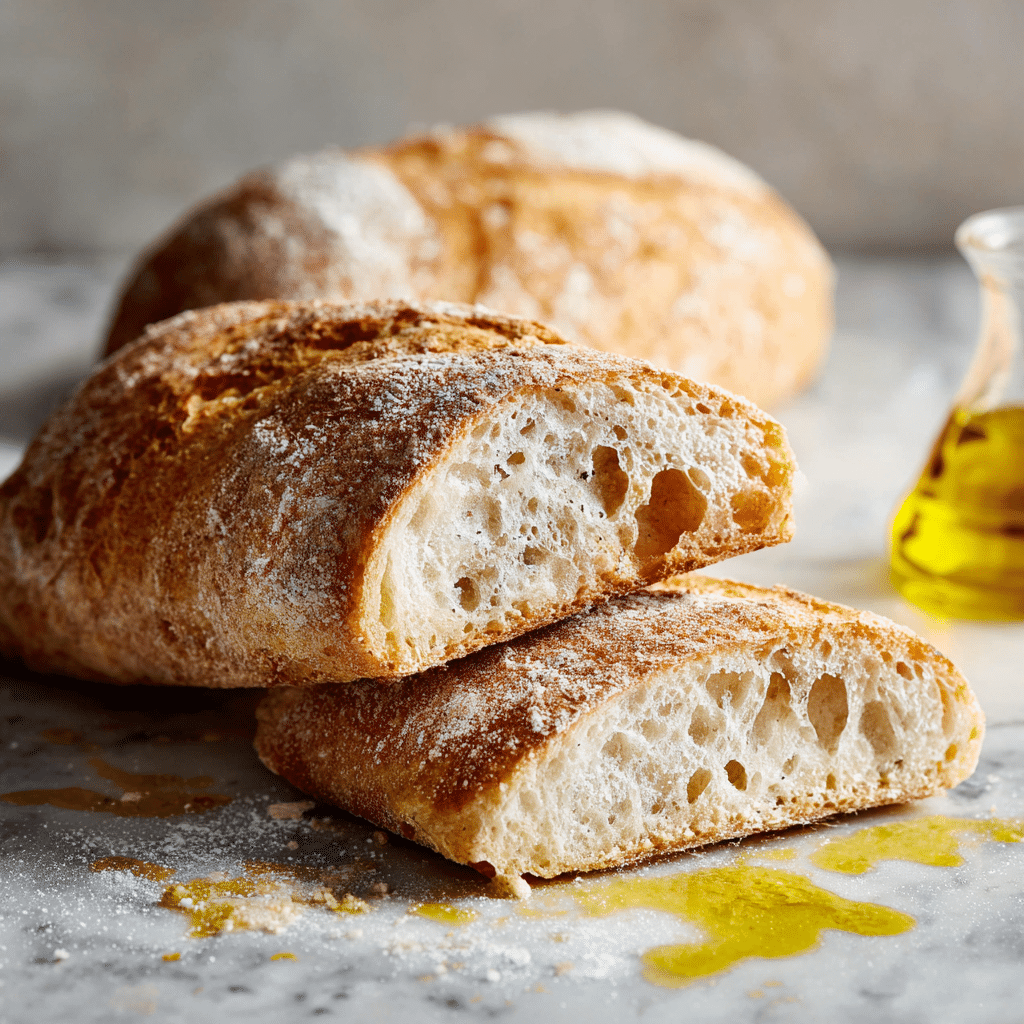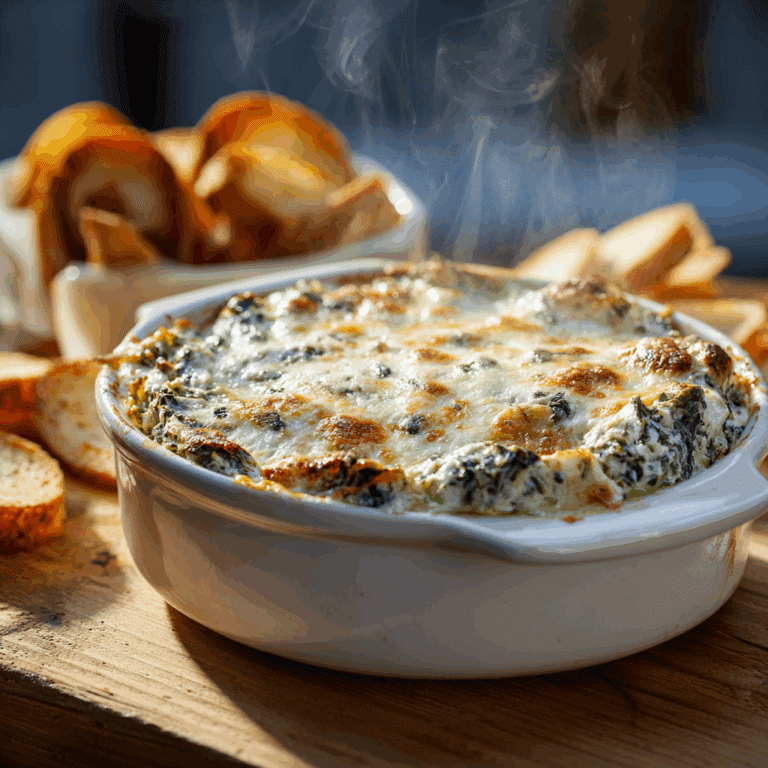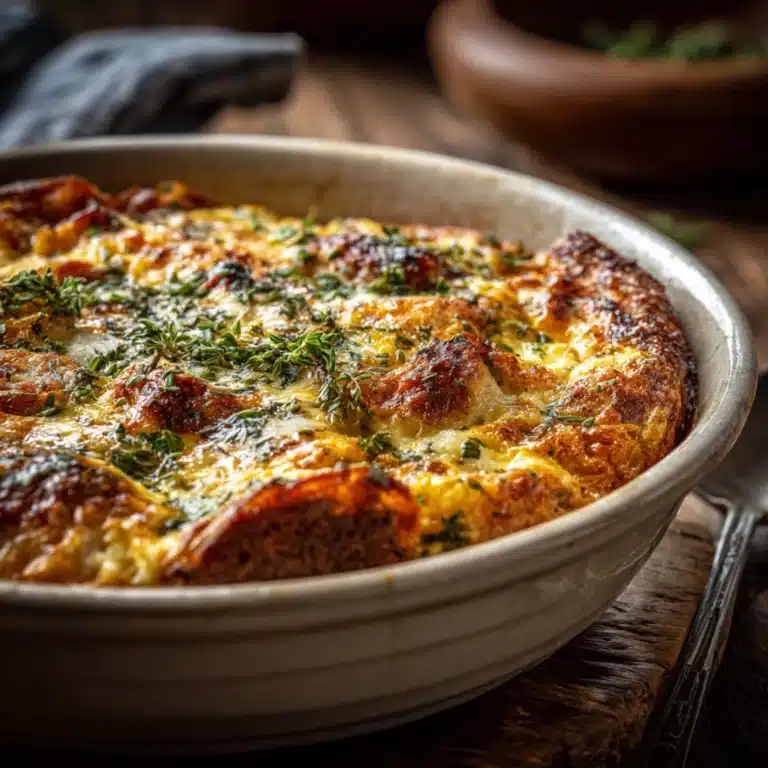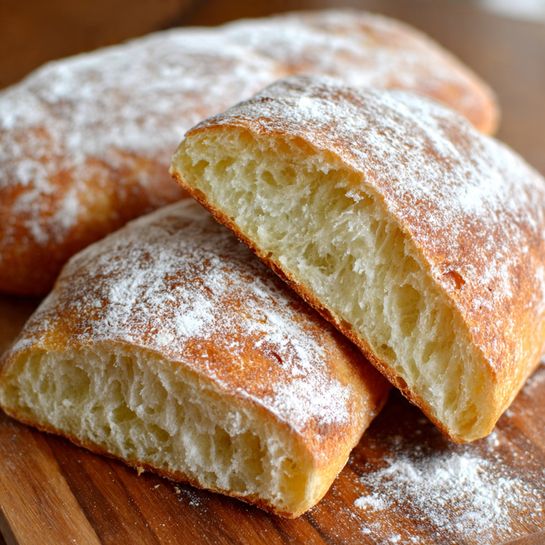Ciabatta (Italy) Recipe
There is something truly magical about baking traditional Ciabatta (Italy) at home. This rustic Italian loaf delights with its open crumb, chewy texture, and delightfully crisp crust, making it an absolute favorite for sandwiches or simply dipping in olive oil and balsamic vinegar. Baking Ciabatta (Italy) invites you into the heart of Italy’s charming bread culture, blending a few simple ingredients into a loaf that feels both artisanal and comforting. Its light, yet chewy texture will win you over bite after bite, leaving you eager to share this Italian classic with friends and family.

Ingredients You’ll Need
Creating authentic Ciabatta (Italy) starts with a handful of simple ingredients, each playing a vital role in developing flavor and texture. These basic pantry staples come together beautifully to give you that unmistakable chewy interior and crackling crust.
- 3 cups bread flour: Bread flour gives the dough enough gluten strength for that airy, open crumb essential to Ciabatta (Italy).
- 1 teaspoon yeast: Yeast acts as the magical leavening agent, creating the light rise and delicate bubbles.
- 1 teaspoon salt: Salt balances the flavors and helps tighten the dough’s structure.
- 1 ¼ cups warm water: Warm water activates the yeast and hydrates the flour for the wonderfully sticky dough.
- 1 tablespoon olive oil: Olive oil adds moisture and a subtle fruity richness, tying the flavors together perfectly.
How to Make Ciabatta (Italy)
Step 1: Mix the Dough
Begin by combining the bread flour, yeast, and salt in a large bowl. Gradually add the warm water and olive oil while stirring until a sticky, shaggy dough forms. The dough should be wetter and looser than many traditional bread doughs—this is key to achieving Ciabatta’s signature open texture. Resist the urge to add too much flour during this step.
Step 2: Let the Dough Rise
Cover the bowl with a clean towel or plastic wrap and let the dough rise at room temperature for about one hour. During this time, the yeast will work its magic, causing the dough to puff up and develop flavor. You’ll know it’s ready when it nearly doubles in size and shows a bubbly surface.
Step 3: Shape the Loaf
After the rise, gently turn the dough out onto a well-floured surface. Handle it carefully—don’t overwork it. Shape the dough loosely into a rectangular or oblong form, just enough to hold together. This relaxed shaping preserves the airy interior that makes Ciabatta (Italy) so special.
Step 4: Bake to Perfection
Preheat your oven to 220°C (about 425°F). Place the shaped dough onto a baking sheet or stone and slide it into the oven. Bake for approximately 25 minutes until the crust is golden brown and crackly to the touch. The loaf should sound hollow when tapped on the bottom, signaling a perfectly baked Ciabatta ready to enjoy.
How to Serve Ciabatta (Italy)

Garnishes
Ciabatta’s neutral yet flavorful character pairs beautifully with a variety of garnishes. Drizzle it with extra virgin olive oil infused with garlic or fresh herbs, sprinkle a bit of flaky sea salt on top, or add a brush of melted butter for an extra indulgent finish. Fresh rosemary or a dash of chili flakes also add great pizzazz.
Side Dishes
This versatile bread shines alongside classic Mediterranean dishes like hearty soups, savory stews, and rich pasta sauces. It’s also an unbeatable companion to a vibrant caprese salad or a rustic antipasto platter loaded with olives, cheeses, and cured meats. Serving it fresh makes every meal feel like an Italian feast.
Creative Ways to Present
Try slicing your Ciabatta (Italy) loaf for sandwiches with fresh mozzarella, ripe tomatoes, and fragrant basil to bring the taste of Italy right to your table. Or turn the bread into crispy crostini topped with bruschetta mix or creamy ricotta and honey for an irresistible appetizer. Toasted slices also make fantastic bases for open-faced sandwiches or paninis packed with bold flavors.
Make Ahead and Storage
Storing Leftovers
If you have leftover Ciabatta, store it in a paper bag or wrapped loosely in a kitchen towel at room temperature. This helps maintain the crust’s crispness while keeping the crumb tender. Avoid airtight containers as they can make the crust soggy, diminishing that prized chewy texture.
Freezing
Ciabatta (Italy) freezes beautifully. Wrap the loaf tightly in plastic wrap and then place it in a resealable freezer bag. When you’re ready to enjoy it again, simply thaw at room temperature, then refresh in a hot oven for a few minutes to revive that perfect crust.
Reheating
To bring your Ciabatta back to life, preheat your oven to 180°C (350°F) and warm the loaf for about 10 minutes. This restores the crunch of the crust and softens the interior, almost as if it’s freshly baked. You can also slice and toast the bread slices for a quick snack that tastes amazing!
FAQs
What makes Ciabatta different from other breads?
Ciabatta is unique because of its high hydration dough and minimal handling, which creates the open crumb structure and chewy texture. Its crust is crisp but not overly thick, making it perfect for soaking up olive oil or sandwich fillings.
Can I use all-purpose flour instead of bread flour?
While bread flour is best for achieving Ciabatta’s signature texture due to its higher protein content, you can use all-purpose flour in a pinch. The crumb may be less airy and chewy, but it will still be delicious.
Why is the dough so sticky?
The sticky dough is intentional and critical for an open crumb. Higher hydration means the dough feels wetter but develops lighter air pockets, which you can’t achieve with stiff doughs.
Do I need a bread stone to bake Ciabatta?
Not necessarily! A baking stone helps create a crispier crust by evenly distributing heat, but a heavy baking sheet works just fine as well. Just make sure to preheat your oven well to get that crusty finish.
Can I make smaller rolls instead of one loaf?
Absolutely! Ciabatta rolls are lovely for individual servings and sandwiches. Shape the dough gently into smaller portions before baking, keeping the same baking temperature but reducing the time slightly until golden and crusty.
Final Thoughts
Baking Ciabatta (Italy) at home might sound intimidating, but with a few simple ingredients and a bit of patience, you’ll be rewarded with a loaf bursting with flavor and rustic charm. The delightfully open crumb and crunchy crust make it a versatile star in any meal. I genuinely encourage you to dive into this experience—you’ll discover how satisfying it is to bring a true piece of Italy right into your kitchen.







